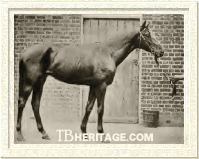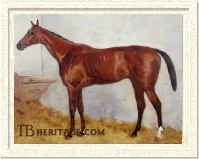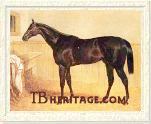|
|
Parmesan

|
|
Parmesan was bred by A. Johnstone from the Verulam mare Gruyere (1851); after he was weaned, his dam, in foal to Pyrrhus the First, was sold to Baron Kotze and sent to Prussia. Parmesan was a small horse, described as a "mere pony." He was sold to Henry Savile -- the illegitimate son of John Lumley-Savile, Lord Scarborough -- a popular member of the Jockey Club and High Sheriff of Nottinghamshire, who had recently inherited the great Rufford Abbey estate in Nottinghamshire from his father. Savile placed Parmesan in training with William Gilbert. For Savile, Parmesan won the Ascot Gold Vase and the Great Metropolitan Handicap in 1861, and ran third to Thormanby in the Ascot Gold Cup.
Parmesan was a good sire in his era, getting two Derby winners -- Favonius and Cremorne -- and a winner of the French Oaks, Brie. Unfortunately his best sire sons, Cremorne and Stracchino, while good filly getters and broodmare sires, did not get sons who could continue the sire line. Parmesan was the grandsire of two top 'chasers, Le Torpilleur in France (Grand Steeple Chase de Paris) and Voluptuary in England (Grand National), and the leading steeplechase sire in Great Britain in the second decade of the twentieth century, Wavelet's Pride, was the grandson of Parmesan's daughter Wanda.
|
|
|

Favonius won the Derby
| | FAVONIUS (1868, from Zephyr by King Tom) was an overgrown chestnut colt bred and raced by Baron Mayer de Rothschild. He did not race at age 2; at age three he ran second to Albert Victor in the Newmarket Biennial, and went on to beat Albert Victor and King of the Forest in the Epsom Derby, ridden by jockey Tom French. Later that year he won the Goodwood Gold Cup, conceding 7 pounds to Albert Victor. In the stud he sired another Derby winner ("the worst ever"), Sir Bevys (1876) from Hampton's dam, Lady Langden, who afterwards developed wind problems and was retired from the turf after a poor showing in the St. Leger. |
|
| This branch of the Parmesan sire line died with Sir Bevys' failure at stud: his son Morglay (1886) did well as Ascot, winning the Ascot Derby (King Edward VII Stakes) and Ascot Gold Vase, but failed to breed on successfully. Favonius' son Eusebe (1876) sired 1889 Grand Steeple Chase de Paris winner Le Torpilleur (1885). Favonius daughter Madame du Barry won the Irish Derby, Irish Cesarewitch, Goodwood Cup, and many other races and was a tough, successful racemare who ran to age seven, then produced seven foals before being sent to Austria. Favonius daughter Folle Avoine was second dam of the French Le Pompom, a fair racehorse and sire; another daughter, Windfall, was dam of the dual-classic winning French filly Wandora (dam of Grand Criterium and French 2,000 Guineas winner and later sire, Val d'Or). |

Cremorne, another Derby-winning Parmesan son
| |
CREMORNE (1869, from Rigolboche by Rataplan), was a rich, red bay, 15.3 hands tall. Bred by Henry Savile, who owned his sire, Parmesan, he proved to be a top runner, especially at a distance. He was one of his generation's top two year olds, winning the Newmarket Two-Year-Old Plate, the Woodcote Stakes, the Chesterfield Stakes, the Hurstbourne Stakes, the York Biennial, and three other races, his only principal loss a third in the Criterion against the speedballs Prince Charlie and Nuneham.
|
At age three he placed second to Prince Charlie in the 2,000 Guineas, but beat him and Pell Mell easily in the Epsom Derby, and, when shipped to France, won the Grand Prix de Paris from the top stayer King Lud (the latter won the 2-1/4 mile Cesarewitch Stakes the following year). He also won the Great Yorkshire Stakes over 1-1/2 miles that year. At age four, he won the Ascot Gold Cup by eight lengths, and the Alexandra Plate by fifteen lengths, and placed second in the City and Suburban Handicap at Epsom to the inferior Digby Grand, the loss blamed on his jockey.
CREMORNE'S most successful racing son was Thurio (1875), who won the Grand Prix de Paris in 1878, the Queen Alexandra Stakes, and the Craven Stakes at Newmarket. He was later a fair filly-getter, some of his daughters racing at or near top class, and a decent broodmare sire of Padua, second dam of Black Servant, and of Darkie, dam of Dark Ronald. Cremorne also sired 1884 Grand National winner Voluptuary, who later had a career on stage, ridden by actor Leonard Boyne at the Drury Lane Theatre. Another Cremorne son, St. George (1883) had a steeplechasing grandson, Red Bud, who won the Maryland Hunt Cup.
Cremorne had several daughters who were highly successful in the stud and good on the racecourse: the black Kermesse (1879), top two year old of her generation, who injured herself before the classics and couldn't run, but did win the Newmarket Oaks and was shared winner of the Select Stakes, beating that year's Derby and 2,000 Guineas winner, Shotover. The good American filly Miss Grillo (1942) descended from Kermesse, as did the good gelding Epsom Lad (1897). Through daughter Montem (1901, winner of July Stakes and others), Kernesse was tail-female ancestress of Ellangowan (1920, winner 2,000 Guineas and others), Colombo (1931, winner of 2,000 Guineas and champion 2 year old), and the good Irish race filly Suntop (1940, Irish Oaks, Irish 1,000 Guineas). Another good Cremorne daughter was Footlight, who established her own branch of Family 1, tail-female descendants including the good juvenile Flotsam (1900); Flair (1903, 1,000 Guineas winner); the good stayer Prince Palatine (1908, St. Leger, Ascot Gold Cup, Doncaster Cup and others); the good American racehorse Bolingbroke (1937, Saratoga Cup, Manhattan Handicap, many others); Bettina (1918, 1,000 Guineas winner), and other classic winners in Europe. |

Stracchino was a winner and sire in France.
| |
Parmesan son STRACCHINO (1874, from Old Maid by Robert de Gorham) was bred and owned by Baron de Alphonse de Rothschild. Stracchino won the the Prix de la Seine and the Prix de la Coupe, and placed third in both the Prix du Jockey Club and the Grande Prix de Paris at age three. He was retired to stud at the Baron's stud, Haras de Meautry, where he sired a number of winners of French races, including Barberine (1882, French Oaks); Germain, winner of the Prix Rainbow; Cleodore, winner of the Grande Poule de Produits in 1889 (later Prix Lupin), and Chopine, winner of the 1889 Prix Greffulhe. His daughters were also good producers: Kelp (1879) was sent to the U.S. and had daughters that bred on.
|
Parmesan's best racing daughter was BRIE (1875, from Stockwell daughter Highland Sister), was also bred and owned by the Baron Alphonse de Rothschild, who had also bred her half-brother, Kilt (1873), winner of the Prix du Jockey Club in 1876. Brie was a good three year old, who won the Prix de Diane (French Oaks), and Prix de Villebon, and ran second in the Prix Daru (to Stathoulder) and the Prix de la Grande Poule (to the superior three year old filly Clementine). She was a successful broodmare, dam of French Oaks winner Brisk (1872, by Galopin), and of French 2,000 Guineas winner Brio (1884, by Hermit).
Another Parmesan daughter, WANDA, through her daughter Wavelet, was second dam of Doncaster Cup winner Wavelet's Pride, and tail-female ancestress of the good race horses Kircubbin (Irish St. Leger) and Ki Ming. Wavelet's Pride, a horse of good speed and great stamina, who also won the Great Metropolitan Handicap and eight other races in his 43 starts, led the leading sire's lists of jumpers in Great Britain between 1913 and 1923, excluding the war years. Irish Grand National winner Amberwave (1916) was by him, and he was damsire of the great 'chaser Golden Miller.
--Patricia Erigero
|
|
|




